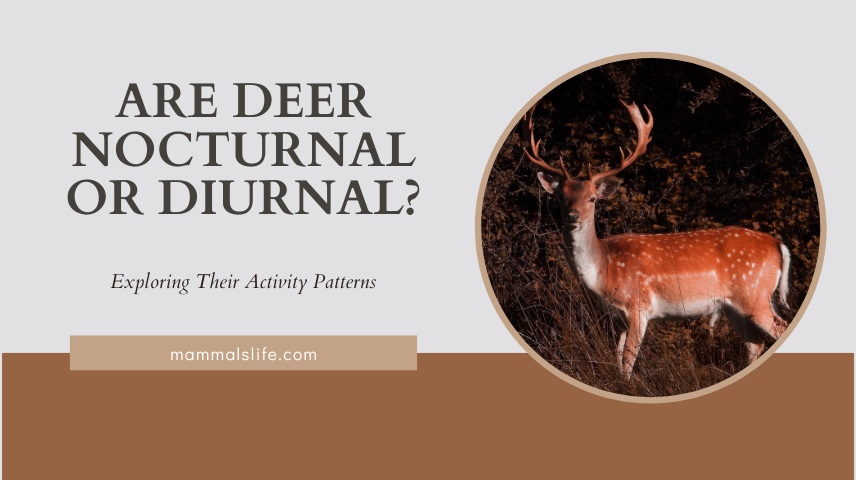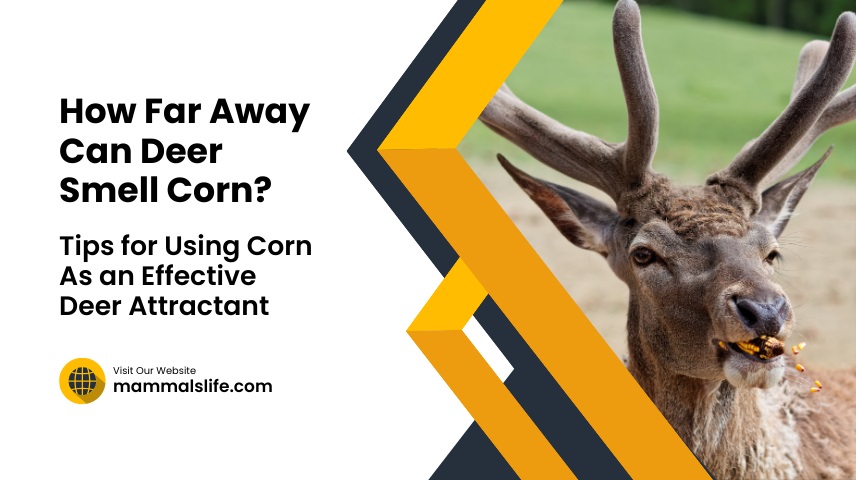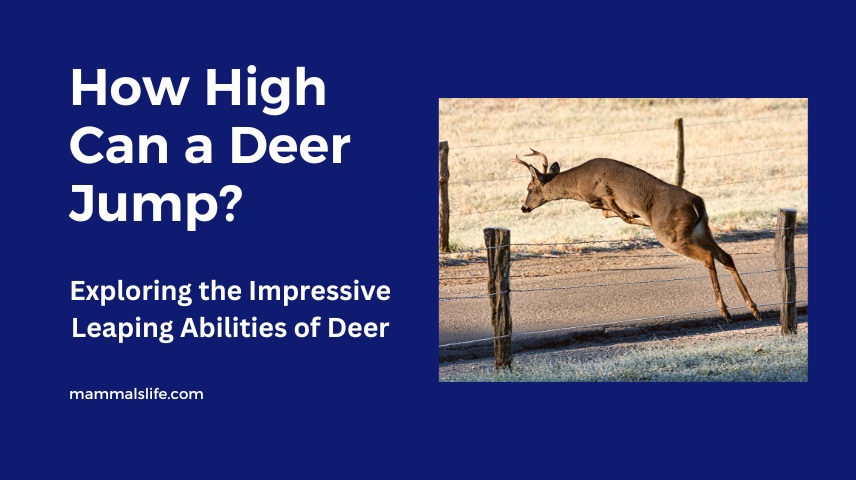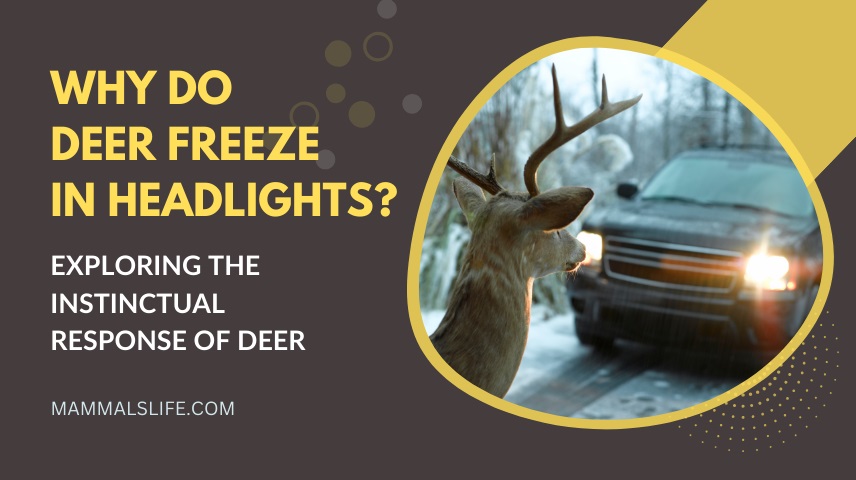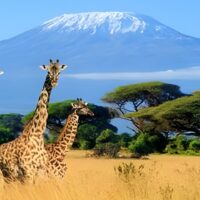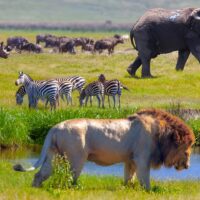Last Updated on February 22, 2025 by Mammals Life
Deer are primarily crepuscular, being most active during dawn and dusk. They can also exhibit nocturnal and diurnal behaviors.
Deer exhibit fascinating activity patterns, often dictated by various environmental factors. While they are most active during the twilight hours of dawn and dusk, they can adapt their behavior based on food availability, predator presence, and human activity. Understanding these patterns is crucial for wildlife enthusiasts, hunters, and researchers.
Deer adjust their routines to optimize survival, finding the best times to forage while minimizing risks. This adaptability makes them intriguing subjects for study and observation. By learning about their activity patterns, we gain insights into their behavior, habitat preferences, and interactions within the ecosystem.
Deer Activity Patterns
Deer are fascinating creatures with unique activity patterns. Understanding these patterns helps in spotting them and learning more about their behavior. Deer are known for their specific daily routines and seasonal changes.
Daily Routines
Deer are crepuscular, meaning they are most active during dawn and dusk. During these times, they forage for food and move around. This behavior helps them avoid predators.
In the early morning, deer leave their bedding areas. They search for food in open fields. By mid-morning, they retreat to shady, secluded spots to rest. In the evening, they repeat the cycle by moving back to feeding areas.
Seasonal Changes
Deer activity patterns also change with the seasons. During the spring and summer, deer are more active. They take advantage of the abundance of food. In the fall, their behavior changes again. They prepare for the mating season, known as the rut.
In winter, deer activity slows down. They conserve energy and seek shelter from harsh weather. Food becomes scarce, so they limit their movements to save energy.
Below is a simple table summarizing their seasonal activity patterns:
| Season | Activity Pattern |
|---|---|
| Spring | Increased activity, abundant food |
| Summer | High activity, foraging |
| Fall | Preparation for rut, increased movement |
| Winter | Reduced activity, energy conservation |
Understanding these patterns helps in observing and studying deer.
Read More – What Is Good to Feed a Baby Deer? Safe And Nutritious Food Options
Nocturnal Behavior
Deer are fascinating creatures with interesting activity patterns. One key aspect of their lives is their nocturnal behavior. Many deer species are active during the night, which helps them survive and thrive in their natural habitats.
Nighttime Foraging
Deer often forage for food during nighttime. This activity is crucial for their survival. By feeding at night, they avoid the heat of the day. They can find food without facing too much competition. Their diet includes plants, fruits, and nuts.
Deer’s night vision helps them find food in the dark. Their large eyes and sensitive retinas pick up even the smallest light sources. This makes nighttime foraging effective.
Predator Avoidance
Another reason deer are active at night is to avoid predators. Predators like wolves and big cats are also active at night. But deer have evolved to be alert and cautious. They use their keen senses to detect danger.
Deer stay close to dense foliage or forests at night. These areas provide cover and safety. If threatened, they can quickly dart into the woods to escape.
| Behavior | Description |
|---|---|
| Foraging | Deer search for food, such as plants and nuts, during the night. |
| Predator Avoidance | Deer searches for food, such as plants and nuts, during the night. |
Understanding the nocturnal habits of deer helps us appreciate these animals. Their survival strategies are truly remarkable.
Diurnal Tendencies
Deer are fascinating creatures. They have unique activity patterns. Many people wonder if deer are more active during the day. Let’s explore the diurnal tendencies of these graceful animals.
Daytime Movements
During the day, deer often move around. They search for food and water. They enjoy grazing in open fields. Deer are highly alert and cautious.
They use their keen senses to detect predators. This helps them stay safe. Deer also travel in groups. This behavior provides added protection.
Sunlight And Safety
Sunlight plays a crucial role in a deer’s life. It helps them see better. Deer prefer to stay in well-lit areas. These areas offer better visibility.
Safety is a major concern for deer. They avoid dense forests during the day. These places can hide predators. Instead, they choose open spaces. This allows them to spot threats easily.
Deer rely on their natural camouflage. Their brown fur blends with the surroundings. This helps them stay hidden from predators.
| Factors | Impact on Deer |
|---|---|
| Sunlight | Improves visibility and safety |
| Open Fields | Preferred for grazing and movement |
| Group Travel | Increases protection |
Read More – Why Do Deer Run in Front of Cars? Tips for Drivers to Stay Safe
Crepuscular Habits
Deer are neither fully nocturnal nor diurnal. They follow crepuscular habits. This means they are most active during twilight. Understanding these habits helps in studying their behavior.
Twilight Activity
Deer become active during dawn and dusk. These periods are known as twilight. During this time, the light levels are low. This helps deer avoid predators. They use this time to move and feed.
Twilight provides a safe cover for deer. They blend into their surroundings easily. This is key for their survival.
Feeding Peaks
Deer have specific feeding peaks. They prefer to graze during twilight hours. This includes early morning and late evening. During these times, they find ample food. They also avoid the midday heat.
- Morning: Deer feed just before sunrise.
- Evening: They graze again before sunset.
These feeding peaks match their crepuscular nature. It helps them stay safe and nourished. Understanding this pattern is crucial for wildlife enthusiasts.
Factors Influencing Behavior
Deer are fascinating creatures with unique activity patterns. Several factors influence their behavior, determining if they are nocturnal or diurnal. Understanding these factors helps us appreciate their adaptability and survival skills.
Weather Conditions
Weather plays a significant role in deer behavior. Deer prefer cooler temperatures and are more active during cooler parts of the day. During hot weather, they seek shade and reduce activity to avoid overheating.
Rain and snow also affect deer movement. Light rain can increase activity as it cools the environment. Heavy rain or snow can limit their movement, forcing them to find shelter.
| Weather Condition | Deer Activity |
|---|---|
| Hot Weather | Reduced activity, seek shade |
| Cool Weather | Increased activity |
| Light Rain | Increased activity |
| Heavy Rain/Snow | Reduced activity, seek shelter |
Human Interaction
Human presence significantly impacts deer behavior. Deer adapts to avoid humans and potential threats. In areas with high human activity, deer become more nocturnal to reduce encounters.
Hunting seasons also affect their patterns. Deer become more cautious and alter their routines to avoid hunters. Urban areas create unique challenges. Deer in these regions may become more nocturnal or adjust their behavior to avoid busy periods.
- High human activity: Increased nocturnal behavior
- Hunting seasons: Altered routines, increased caution
- Urban areas: Adjusted behavior to avoid humans
Understanding these factors helps us coexist peacefully with these magnificent creatures. By respecting their space and patterns, we contribute to their conservation and well-being.
Read More – What to Feed a Deer in the Winter? Safe And Nutritious Winter Feeding Options
Research And Observations
Understanding whether deer are nocturnal or diurnal involves detailed research and observations. Scientists have used various methods to track deer activity. This helps in understanding their behavior patterns.
Tracking Methods
Researchers use several tracking methods to study deer. Each method provides valuable data:
- GPS Collars: These collars provide accurate location data.
- Camera Traps: Cameras capture images of deer at different times.
- Direct Observation: Scientists observe deer in their natural habitat.
These methods help gather data on when deer are most active.
Key Findings
Research shows that deer activity depends on various factors. Here are some key findings:
| Factor | Impact on Activity |
|---|---|
| Season | Deer are more active in the fall. |
| Time of Day | Most deer are crepuscular, active at dawn and dusk. |
| Predator Presence | Deer are more nocturnal in areas with predators. |
The research reveals that deer adapt their activity based on the environment.
Frequently Asked Questions
Are Deer Nocturnal Or Diurnal?
Deer are primarily crepuscular, meaning they are most active during dawn and dusk. They can also be active at night.
Are Deers Active At Night Or Day?
Deers are primarily crepuscular, meaning they are most active during dawn and dusk. They may also be active at night.
What Is The Sleep Pattern Of A Deer?
Deer have a polyphasic sleep pattern, sleeping in short intervals throughout the day and night. They often rest for a few minutes at a time, remaining alert to potential threats.
Are Deer Still Nocturnal?
Yes, deer are still primarily nocturnal. They are most active during dawn and dusk, avoiding predators.
Are Deer More Active At Night?
Deer are primarily crepuscular, meaning they are most active during dawn and dusk.
Conclusion
Understanding deer activity patterns helps us coexist with these fascinating creatures. Deer are primarily crepuscular, active during dawn and dusk. Knowing their habits aids in wildlife conservation and safety. Always observe from a distance to respect their natural behavior. Stay informed to appreciate the delicate balance of our ecosystem.

